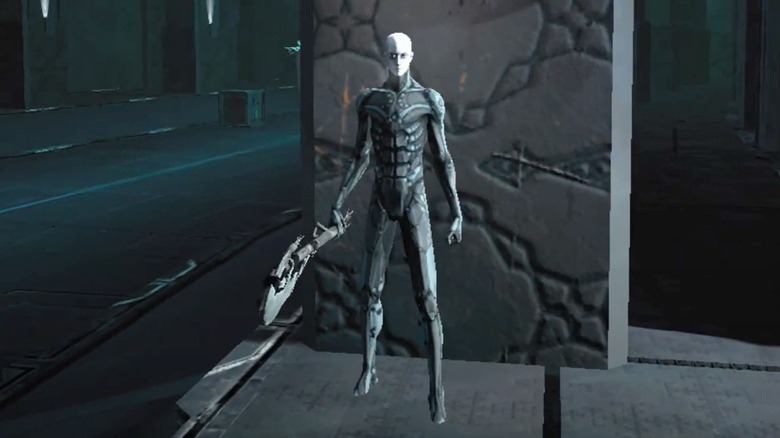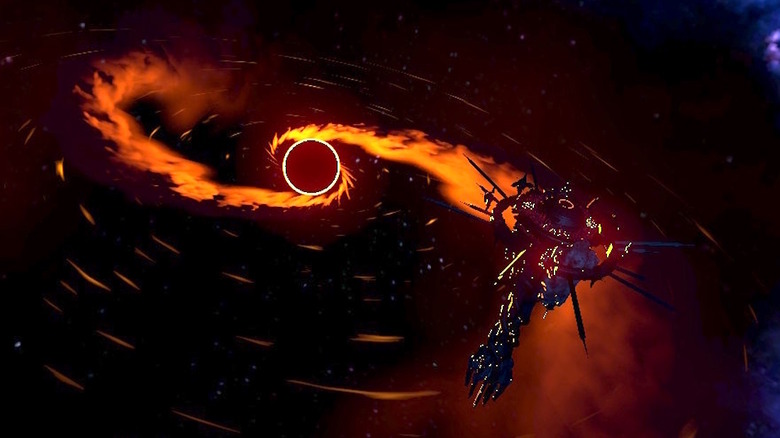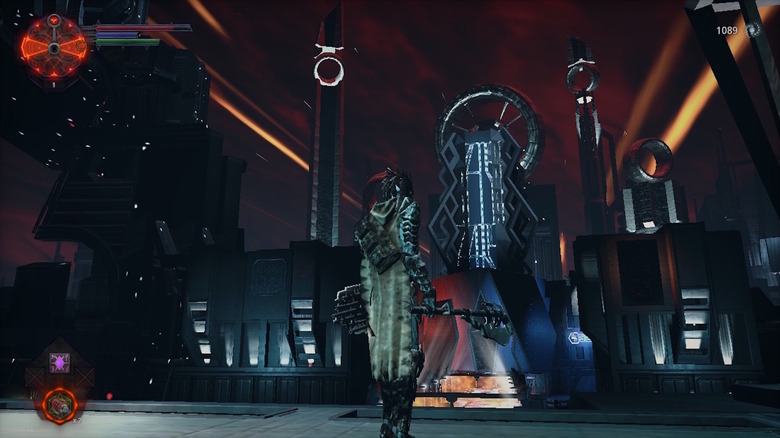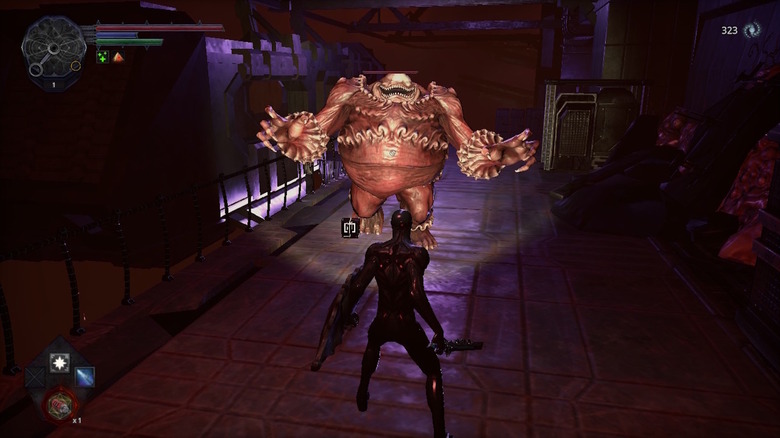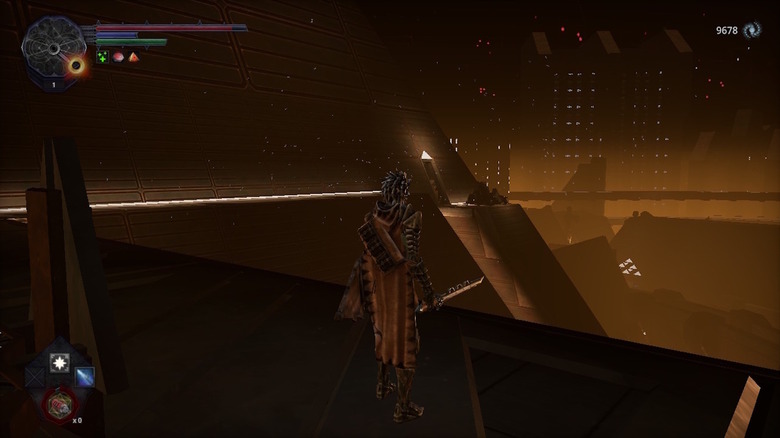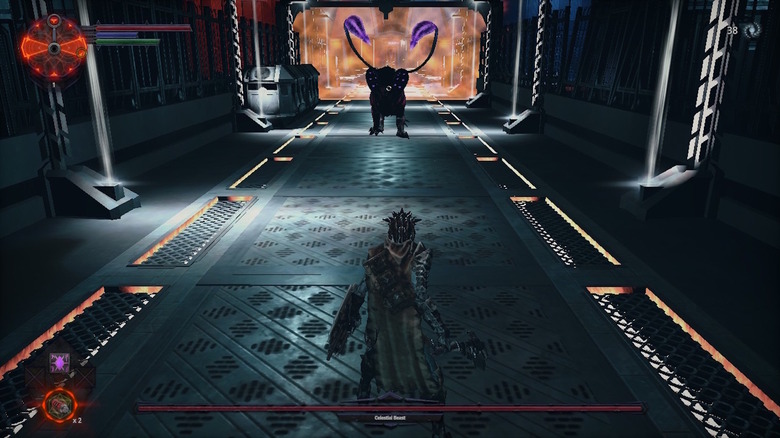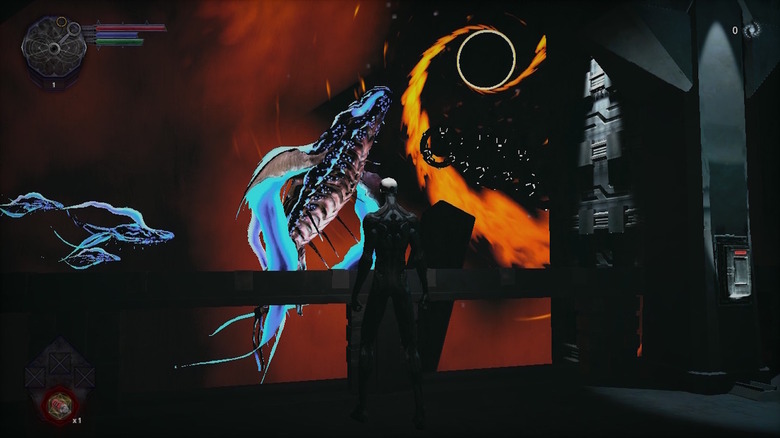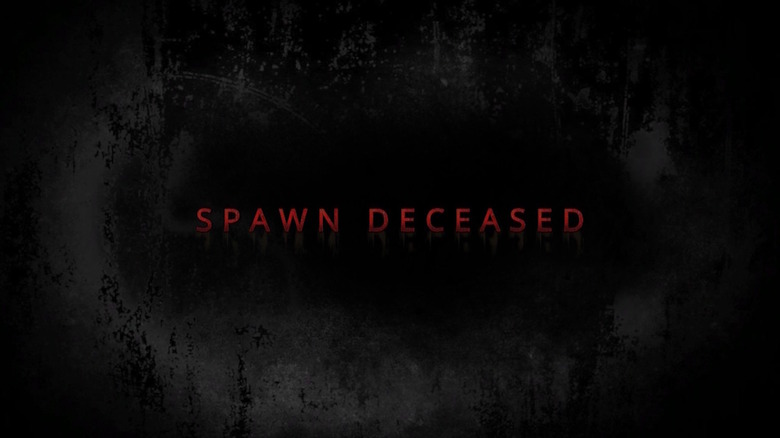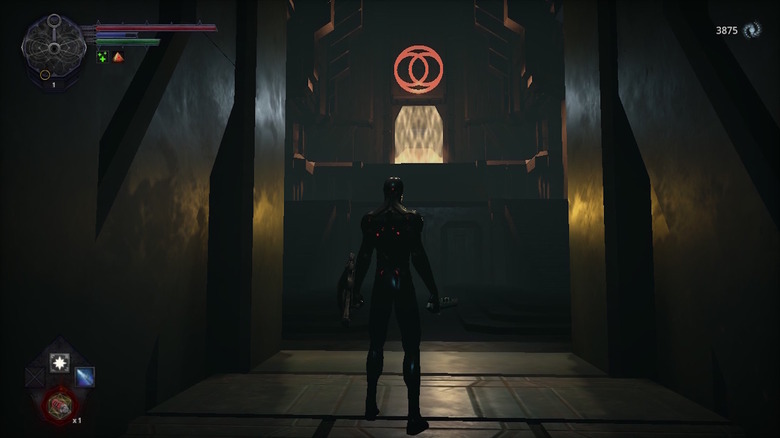Hellpoint (Switch) Review: A Neat Sci-Fi Spin
- Interesting and appropriately bleak setting
- Plenty of environmental variety
- Satisfying exploration and shortcut finding
- A few interesting spins on a familiar genre
- Way too dark at times
- Looser combat than its contemporaries
- Attacks sometimes hit or miss when they shouldn’t
- Bugs can significantly drag things down
It's both reductive and accurate to describe "Hellpoint" as something like "sci-fi 'Dark Souls,'" because like many 3D action RPGs that came after the 2011 classic ("Demon's Souls" was first in 2009 but mostly flew under everyone's radar) it follows a lot of the same gameplay beats. You probably know the drill by now. Killing enemies to earn a sort of currency used to buy equipment or increase character stat levels, branching paths and shortcuts to unlock, deliberate timing-based combat, and so forth.
Despite those similarities, I do consider "it's 'Dark Souls' but sci-fi" a somewhat unfair summary because "Hellpoint" does carve out its own identity within the space (no pun intended). It's by no means a replacement for or alternative to From Software's monolithic series, but I do believe it has a place alongside it — offering a similar-yet-different experience, along with its own unique adjustments to the popular formula.
Also, I'm totally a sucker for dark, bleak, twisted science-type stuff. And I mean anything from the beloved PC "System Shock" series and criminally underappreciated mobile horror game "Mission Europa," to movies like 1997's "Event Horizon" and even "Virus" from 1999. This isn't to say "Hellpoint" eclipses any of these works (okay, maybe "Virus"), but it captures a similar vibe and I'm here for that.
Scientific progress goes 'boink'
Behold the massive city-sized (possibly more like state-sized?) space station of Irid Novo. A pinnacle of science and engineering and home to a whole heck of a lot of people. At least it was until something really bad went down and now just about everyone is dead or much, much worse. And that's where you come in.
Sometime after whatever this major event, called "the Merge," was (unfathomably large amounts of ritualistic sacrifice seem likely), you're conjured into being by an entity calling itself "The Author." Maybe it's a benevolent station-wide AI, or maybe it's part of the problem — but you just popped into existence, and being one of the only self-aware living beings on a derelict space station is a lot to process right out the gate.
And just like that, you're off. No starting gear of any kind, and all stats are level 1. Go forth and try to figure out what's going on by synchronizing rifts (the game's version of bonfires, a.k.a. A place to rest and level up) and exploring the bowels of the station.
Signs of Irid Novo's troubles aren't limited to the bodies and bloodstains, however. The structure also orbits around a black hole that may be connected to The Merge somehow, which can affect the world around you depending on their locations relative to each other. Enemy positions may change, new creatures may appear, or you may even run into a boss that wasn't there before.
Enter the void
I really like Irid Novo as a setting. It's utterly massive, which makes the sprawling environments a bit more believable (within the context of a video game), but much of the architecture is also very gothic and lends itself well to the eerie, oppressive atmosphere. I was also surprised at just how much variety there is to the game's locations. Between the somewhat ornate-looking Embassy you start out in, to the rotten growths in Port Issoudun, to the almost disturbingly ordered halls of the Arisen Dominion, I haven't been wanting for visual variety.
Enemies found in these areas also offer a bit of nuance, with some types appearing in multiple locations but each major zone typically has at least one or two stand-out creatures. That being said, it's a little less impressive just how often bosses end up being recycled as downsized regular enemies the further you go. It's not an uncommon practice, but I've seen so many of them repeated later down the line it's taken a lot of the impact out of other boss fights.
Navigation has also been a bit of a mixed bag, especially in the early game. Irid Novo is a dark place. Like, literally dark. Sometimes too dark to see where I'm going, which wasn't so much tense as it was irritating. This can be helped by adjusting the light levels in the options — and by eventually finding a flashlight tool — but I've lost count of the number of times I've almost run off a cliff because I couldn't see more than a few virtual feet in front of my character.
Getting around
As impressed as I've been with the setting in "Hellpoint," it didn't start out that way. The unnecessary levels of darkness certainly didn't help, but my problem was mostly the way the game decides to boot you into the thick of things.
Now, I have no problem with starting empty-handed. My go-to starting class in any "Dark Souls" style game is Deprived because I like having a little more wiggle room in where I allocate my levels and I enjoy the challenge of having to find equipment. But "Hellpoint" is far less generous with item drops and there's practically no armor to be found before you face your first boss. It's possible to acquire some from a few of the enemies you'll encounter, but after a whole lot of killing, they only provided me with one pair of pants and something like eight or so helmets. That's not great.
Thankfully it gets better once you push past that first boss and make it to The Observatory. There you'll find a full armor set, along with other useful tools and machines you'll definitely be returning to later. And past that, much larger locations start to become available. Many of which have multiple paths to explore, a surprising number of secrets to find (possibly even more than the series that inspired this whole thing), and some sweet, sweet shortcuts to unlock. This is where "Hellpoint" really started to click with me, as exploration (satisfying exploration) has always been my favorite aspect of these types of games.
Bugs, bugs, bugs
Admittedly, as much as "Hellpoint" has gotten its hooks into me, it is a bit buggy. The performance does appear to be improved compared to the stories I'd seen and videos I've watched of earlier versions, but some locations (such as the Sohn District or the more open areas found in the Arisen Dominion) do stutter and chug a bit. This in itself can be annoying but isn't really a dealbreaker. One time my game loaded and my character model and most of the level were invisible, but this only happened once and everything went back to normal within a minute or so.
Another bug I encountered is the "fungal spores floating in the air" effect that can be seen in a particular area of Port Issoudun. I opened it up, explored for a bit, then decided to travel elsewhere but the visual effect persisted no matter where I went. Though it went away after quitting and re-opening the game.
This is all not great but manageable. What's far more irritating is the crashing. Things aren't so bad now for some reason, but "Hellpoint" has crashed on me about six or seven times at this point — four of which happened in a single day while I was in the Sohn District. There was a lot of crashing while loading around there for some reason. Though the game did also lock up on me after reloading at one point.
Combat
I wish I could say combat in "Hellpoint" is on par with something you'd experience in a Fromsoft game, but that's definitely not the case. It's not terrible by any means, but characters, attacks, and dodges feel a little "floaty" and disconnected. The timing never feels quite right, and there have definitely been moments where I was hit when I shouldn't have been or missed an attack that absolutely should have connected. On more than one occasion I've even struck an enemy multiple times without doing any damage, even though I was seeing damage numbers appear next to their health bar.
On top of the imprecise combat, there's the issue of Tenacity. This is essentially the equivalent to Poise, and it affects when your attacks interrupt enemies and when their attacks interrupt you. Problem is that this isn't explained very well (or at all, really), and it, again, doesn't seem particularly well-balanced.
Many enemies can unleash a flurry of attacks that will often break your guard after only two or three strikes, while very few enemies will stagger after concurrent hits. What's worse, unlike other similar titles, when you get staggered in "Hellpoint" there's not really anything you can do about it. There's no way to roll out of the way at the last second — you just have to stand there and hope you'll be able to dodge away after the first follow-up attack inevitably hits you.
Doing its own thing
Most of the unique twists "Hellpoint" tries to add to the familiar "Dark Souls" formula are also pretty interesting, though base-level elements like gathering "souls" (or "axions" in this case) to increase stats or pay for gear, and dropping it all when you die so you have to go back and retrieve them or they're gone forever, are ever-present.
One such change I kind of like is how equipment is handled. You can and will absolutely find weapons and armor scattered around the station, or via enemy loot drops, but you'll also find blueprints. These can be used to produce new or upgraded versions of equipment, but the catch is you need to have the right materials and access to a Universal Printer (or Occult Conjuring Table, depending on the item). It sounds silly but I actually like finding blueprints and eventually going back to try and print them, in addition to finding materials around the environment or farming them from enemies.
The Omnicube is another addition I appreciate, because once you find one it becomes a sort of universal tool that you can find even more programs for. It can warp you back to the last rift you visited at no cost, act as a (much-needed) flashlight, leave a trail for you to follow in case you get lost, and so on.
Heal turn
Unfortunately not all of the gameplay elements "Hellpoint" is experimenting with work super well. Of particular note is the way healing is handled. You do have a refillable healing item, and it can be used fairly quickly to bring you back up to full once per use, but there are two problems with this. First, you start with a maximum of only two uses so it's easy to run out quickly — particularly early on. Second, refilling is tied to damaging enemies or dying rather than visiting rifts — and it takes an awful lot of hits for a single refill.
I was intrigued by this approach to healing at first, and I do think it has its merits, but the balance is off by a wide margin even once you get past the early game stuff. Some weapons will refill your healing faster, which is nice, but it still takes an unbearably long time and you'll be stuck at that two-use limit for what feels like an eternity.
What puzzles me, even more, is that Energy (basically your magic meter) functions the same way in that it refills as you damage enemies, but it refills at a significantly faster rate. Maybe even a little too fast. So why is the healing recharge rate so stingy?
Hellpoint (Switch) verdict
If I'm being honest, I'm a little disappointed with "Hellpoint." Not because I don't like it — I actually began to enjoy it quite a lot once I was able to find some proper equipment, improve more stats, and found the flashlight. The problem is I know I would absolutely adore it with a little more refinement, some minor rebalancing, and fewer bugs.
It's almost the game I was hoping it would be, and it's close enough that I still find it incredibly difficult to put down. It's just a shame it didn't quite live up to my expectations — let alone its own potential. Still, what's here scratches enough of the itch to justify the $35 price — and even more so the $17.49 it was on sale for when I purchased "Hellpoint" from the eShop. And really, for the money, I think it delivers more than enough.
But when I imagine what it could have been, and what comes so close to being, it still bums me out a little. Ah well, I suppose I can always hope for a sequel somewhere down the line. Or at least cross my fingers that the Blue Sun DLC that came out in the summer of 2022 will eventually make its way to the Switch. Flawed as it is, I really do want more. Until then, more Prodeus and Moonscars.
